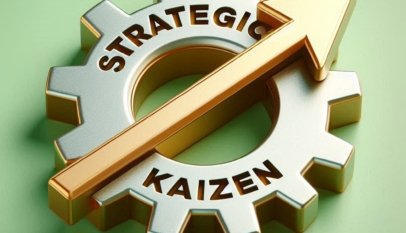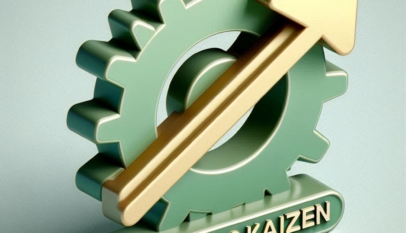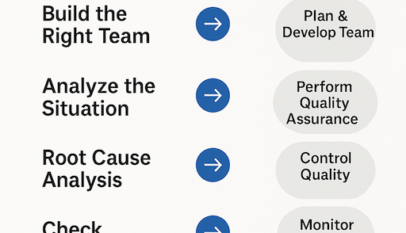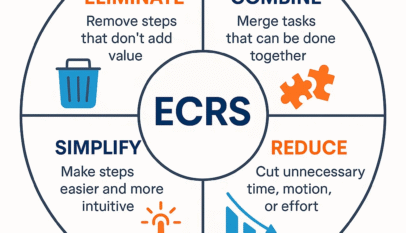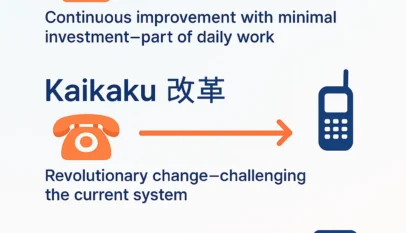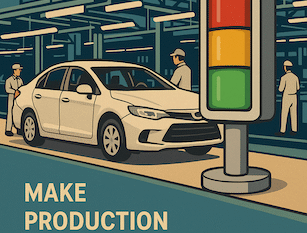
In today’s fast-paced business landscape, sustainable competitive advantage demands more than incremental improvements. Organizations must eliminate inefficiencies and maximize performance to stay ahead.
Strategic KAIZEN focuses on systematic, strategic improvement to optimize operational flow. It combines managerial oversight for project selection with small group workshops for effective implementation. By continuously targeting non-productive areas and calculating related costs, organizations can eliminate waste and losses and drive significant performance improvements. This approach requires time and resources but promises substantial returns, including doubling productivity and a fivefold increase in ROI. For top management, prioritizing Strategic Kaizen is crucial for sustaining business strategies. It aligns all organizational levels with the company’s vision and mission, setting continuous productivity growth targets and rigorously measuring outcomes to align with long-term goals.
Strategic KAIZEN for TAKT PROFIT synchronizes profitable operations through comprehensive involvement at all levels, ensuring the company moves strategically and outpaces the competition. It shifts the focus from “OR” to “AND” for key performance metrics, integrating quality and cost simultaneously.
Shifting from ‘OR’ to ‘AND’ for Superior Management Synergy
The Strategic KAIZEN Path shifts from “OR” to “AND” thinking. Clients often struggle to balance quality and cost or profit margin and market share. Top companies achieve sustainable growth by pursuing dual goals like quality and cost, and short-term and long-term objectives. Companies stuck in “OR” thinking fail to excel (as it would come: quality OR cost). In manufacturing, quality is essential, but achieving contradictory goals while enhancing quality is a competitive advantage. Strategic KAIZEN focuses on “AND” through detailed data-driven mechanisms.
For instance, a major auto parts manufacturer using Strategic KAIZEN boosted productivity and cost competitiveness by multiplying production speed and reducing production line area, achieving near-zero defects and complaints. High goals like N-fold productivity and zero defects require innovative thinking and revolutionary changes in production methods. This mindset is crucial for executing “AND” strategies. However, many fail to deeply consider quality and cost, opting for short-term fixes. Incorporating Strategic KAIZEN wisdom differentiates and creates consistent competitiveness.
To achieve high-level “AND” through the Strategic KAIZEN Methodology for Takt Profit, consider these KPI pairs with their possible annual results (as an average of projects carried out in different companies in different industries):
- Production Volume AND Quality: Traditionally, increasing production volume can compromise quality. However, by synchronizing processes through Strategic Kaizen projects and leveraging real-time data analysis (e.g., KAIZENshiro Budget), companies can achieve a 25% increase in volume and a 35% improvement in quality.
- Profit Margin AND Market Share: Enhancing profit margins often means higher prices, which can reduce market share. Strategic Kaizen optimizes costs and enhances value propositions, resulting in a 12% rise in profit margins and an 8% growth in market share.
- Cost per Unit AND Employee Morale: Cost efficiency initiatives can negatively impact employee morale. Strategic Kaizen involves employees in strategic process improvements, leading to a 10% reduction in cost per unit and a 15% boost in morale.
- Cycle Time AND Flexibility: Reducing cycle time can limit operational flexibility. By integrating flexibility into operations through modular systems, multipurpose training, and above all innovatively redesigning work methods, Strategic Kaizen can achieve a greater than 40% reduction in cycle time and a greater than 50% increase in flexibility.
- Utilization Rate AND Maintenance: High utilization rates often lead to increased maintenance downtime. Strategic Kaizen emphasizes predictive maintenance and balanced utilization using IoT and machine learning, resulting in a 30% increase in utilization rate and a 50% reduction in maintenance downtime.
- Inventory Turnover & Customer Satisfaction: High inventory turnover can risk stockouts, harming customer satisfaction. Strategic Kaizen’s demand-driven inventory management aligns stock levels with real-time demand and profit data, improving turnover by 25% and boosting customer satisfaction by 22%.
- On-Time Delivery & Manufacturing Costs: Ensuring on-time delivery can raise manufacturing costs. Strategic Kaizen optimizes processes and resources, improving delivery rates by 20% while reducing costs by 12%.
- Customer Returns & Production Flexibility: Reducing customer returns often limits production flexibility. Strategic Kaizen integrates quality control with flexible production, cutting returns by 30% and enhancing flexibility by 20%.
- Order Fulfilment Time & Inventory Levels: Faster order fulfillment can increase inventory costs. Strategic Kaizen’s flexible management and forecasting reduce fulfillment time by 22% and optimize inventory levels by 25%.
- Safety/Health Incidents & Production Efficiency: Implementing safety measures can slow production. Strategic Kaizen integrates safety with efficiency, reducing incidents by 25% and boosting efficiency by 15%.
Overall Balance: These KPIs require a strategic balance, coordinated by Takt Profit and KAIZENshiro, and executed through Strategic KAIZEN projects.
What is TAKT PROFIT?
“The Takt Profit is the rate at which the unitary target profit of the period must be met”, Posteucă, 2021, p. 22, or “the target profit per minute in the bottleneck operation”, Posteucă, 2021, p. 21. Takt Profit is the pole star of Strategic Kaizen. It ensures synchronized, profitable operations by meeting key stakeholder targets and takt time goals. This approach optimizes resource allocation, minimizes waste and losses, and enhances flexibility to meet customer demands. Continuous strategic change and successful implementation of Strategic Kaizen projects drive this efficiency, adapting to market and internal shifts seamlessly.
Top executives frequently grapple with the challenge of balancing seemingly contradictory KPIs. The Strategic KAIZEN methodology, through TAKT PROFIT, offers a robust solution that transcends the traditional “OR” logic, embracing an “AND” approach to drive performance. By leveraging Strategic KAIZEN projects, organizations can harmonize these conflicting KPIs, achieving unparalleled operational and financial success. Please see the figure below.

What is Speed-Based Target Profit (SBTP)?
Speed-Based Target Profit (SBTP) is the profitable production management targeted for achieving Synchronous Profitable Operations (SPO) based on reaching the target profit per minute in the bottleneck operation by planning and improving both the capacity of the bottleneck operation and the CLW (cost of losses and waste) for all operations. (Posteucă, 2021, p. 21).
How is Speed Based Target Profit (SBTP) calculated?
SBTP enables manufacturing companies to maintain profit margins under varying sales conditions through Strategic Kaizen projects. Takt Profit measures the rate at which unit profit is generated by capacity and profit bottleneck modules. It can be calculated for any timeframe and product count. Enhancing unit profit contribution primarily involves reducing variable costs, especially indirect ones. The ultimate goal is to achieve net target operating income or EBIT, contributing to ROI. Please see the figure below.

As Peter Drucker famously said, “What gets measured, gets managed.”
Top managers should leverage Strategic Kaizen to optimize Takt Profit, ensuring sustained profitability and operational excellence.
I extend my sincere gratitude for your time and attention in reading my article on Takt Profit. Your engagement is highly valued and greatly appreciated. I look forward to any feedback or discussions this may inspire. Alin Posteucă

